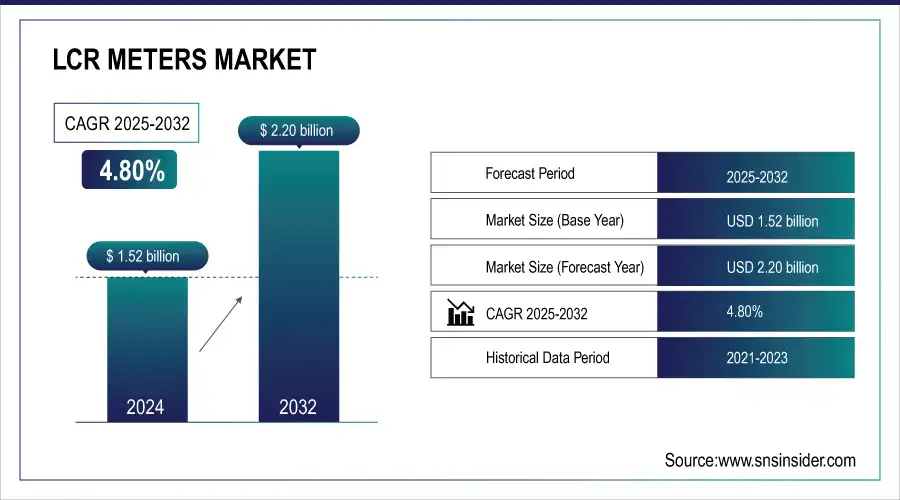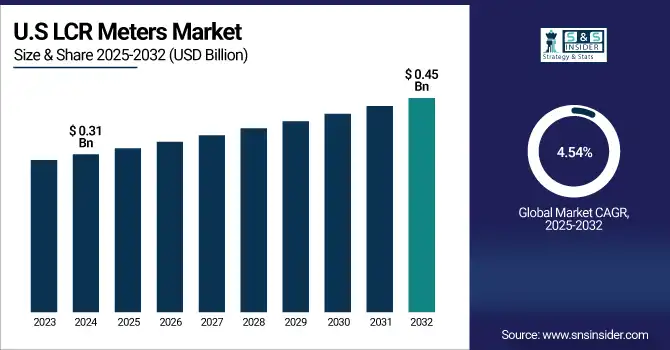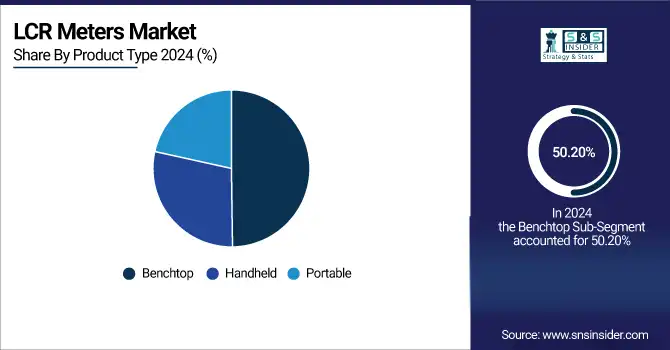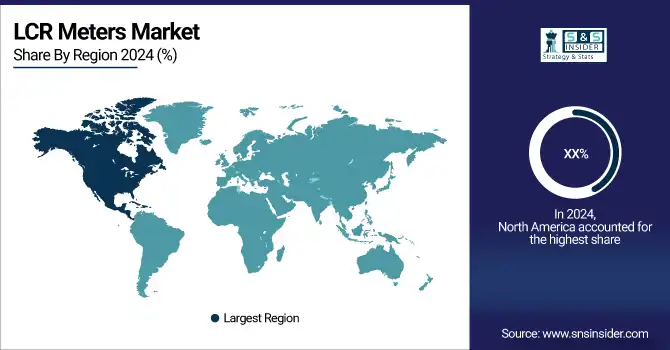LCR Meters Market Size & Growth:
The LCR Meters Market size was valued at USD 1.52 billion in 2024 and is expected to reach USD 2.20 billion by 2032 and grow at a CAGR of 4.80% over the forecast period of 2025-2032.

To Get more information On LCR Meters Market - Request Free Sample Report
The global market report provides key trends, market size, growth drivers, restraints, regional insights, opportunities, competitive landscape analysis. This segmentation enables an accurate LCR meters market analysis by the size of the market by product type, frequency range, application, and end-user industry. Growing adoption of LCR meters in electronics and automotive industries and technology advancements coupled with changing landscape of test and measurement instruments are few of the key characteristics rendering unique growth angles in the global LCR meter market.
For instance, more than 60% of engineering and technical institutes globally have incorporated advanced LCR meters in their laboratory curriculum and research practices.
The U.S. LCR meters market size was USD 0.31 billion in 2024 and is expected to reach USD 0.45 billion by 2032, growing at a CAGR of 4.54% over the forecast period of 2025–2032.
The U.S. market is driven by the key investments in electronics R&D, high demand for quality control tools, and adoption across aerospace & defense, and automobile industries. This, in addition to the factors that support the ubiquity of semiconductor and circuit testing equipment by the manufacturers at the forefront of innovation, continues to sustain market growth. All of these factors together contribute to the LCR meters market growth, especially in North America.
For instance, over 80% of defense contractors in the U.S. employ LCR meters for reliability testing in mission-critical systems and communication modules.

LCR Meters Market Dynamics:
Key Drivers:
-
Surging Demand for Electronic Testing in Consumer Electronics and Automotive Sectors Drives Market Growth Rapidly
The miniature nature of devices in consumer electronics and automotive is promoting high usage of electronic components hence demanding high capacity test instruments as LCR meter. Consumer electronics is steadily shrinking, while a wider range of automotive systems needs has increased for more advanced components for EVs and ADAS, pushing manufacturers to require higher precision tooling for reliable parts. They are indispensable in mass production and also in R&D environments, where LCR meters are the backbone of capacitance, inductance, and resistance measurements during design, production, and quality control tests.
For instance, modern smartphones can contain over 1,000 capacitors, inductors, and resistors, each requiring accurate validation during assembly.
Restraints:
-
Complex Calibration and Maintenance Requirements Create Operational Challenges for Long-Term Usage of LCR Meters
LCR meters can remain accurate over time, but the comfort of hand-held LCR meters has to be justified by additional, often highly-skilled, personnel involved in their regular calibration and external accessories. Aligning frequency responses, upgrading firmware, and troubleshooting signal integrity problems require a technical skill set that is not always available in every operating environment. However, for a lot of end-users, especially in low tech regions or industries, these challenges prevent widespread adoption and attractive integration in day-to-day testing infrastructure leading to reduced overall penetration in the market.
Opportunities:
-
Rapid Proliferation of Electric Vehicles and Battery Technologies Spurs Demand for High-Frequency and High-Precision Testing
The electrification of transport globally has created new opportunities for LCR meters in battery, powertrain and BMS testing. The passive components which are used both for energy storage and control electronics must undergo thorough validation in an electric vehicle. Also, for on-site diagnostics and maintenance of EVs, high-frequency and portable LCR meters are gaining importance, thereby opening lucrative opportunities for manufacturers to develop application-specific instruments to address this high-growth vertical. One of the notable LCR meters market trends is growing EV integration.
For instance, portable LCR meters can reduce diagnostic time by up to 40% during field maintenance of electric vehicles.
Challenges:
-
Presence of Alternative Testing Instruments with Broader Capabilities Hampers LCR Meter Market Penetration
Impedance analyzers and network analyzers are multifunctional testing devices providing overlapping features with LCR meters but with improved versatility. These kinds of alternatives seem more cost efficient for all organizations which need to optimize the testing infrastructure and reduce the number of equipment. Such competition undermines the addressable market for LCR meters, particularly in R&D labs and OEMs requiring more comprehensive characterization tools, threatening market exclusivity and long-term growth.
LCR Meters Market Segmentation Analysis:
By Product Type
The benchtop segment accounted for 50.20% revenue share of the overall LCR meters market in 2024. With high precision alongside wide frequency ranges and additional advanced testing capabilities, these devices are ideally suited for R&D laboratories and quality control departments. Keysight Technologies has some benchtop models that have precision capabilities appropriate for lab environments, and they are just one example. This capability to manage complex component measurements keeps fueling their adoption in many high-performance testing industries.
The portable segment is estimated to be the fastest with CAGR of 5.26% during 2024–2032, since these are demanding solutions that can be deployed in the field. There is also a growing dependence on real-time diagnostics and onsite maintenance across the industries. GW Instek's GENLCR series of versatile industrial LCR meters offered in a compact form factor for portability in challenging industrial environments. These are affordable, and easy to use which perfectly fit the requirement of remote inspections, utilities, and field service applications, contributing to market growth.

By Application
In 2024, test frequency accounted for the largest revenue share of 28.23% of the LCR meters market share owing to its significance of evaluating the circuit behavior at multiple frequency levels. It is still found use in production and R&D test. As components have to be evaluated for their reliability, at the same time, the industry needs sophisticated LCR meters which are ideal for frequency response testing, and hioki E.E. Corporaiton offers just such high-grade LCRs which can ensure the workability and reliability of the components. Their devices find heavy usage in telecom, power electronics and semiconductor application areas in which signal fidelity has become a critical consideration.
Accuracy segment is anticipated to witness fastest CAGR of 6.45% during 2024–2032 owing to requirement of ultra-precise validation. This largely due to high relevance in the aerospace, medical, and defense markets. Chroma ATE Inc. is a manufacturer of LCR meters that have high accuracy and are designed and built in compliance to the industry standards. They are desirable for reliability testing in some life or safety critical applications as they can measure small variations in component characteristics that may affect reliability.
By Frequency Range
The medium frequency segment accounted for the largest revenue share of 39.80% in 2024. Several manufacturers such as B&K Precision, have launched LCR meters working at medium- frequencies for production line or service centers. This segment finds its footing well, supported by strong volume absorption across consumer electronics, industrial controls, and related end-markets, which makes it a preferred option for general-purpose testing.
The high frequency segment is projected to grow at the fastest CAGR of 5.28% during 2024–2032 owing to it being more commonly utilized in RF systems and 5G. RF LCR meters notably from Wayne Kerr Electronics are built for MHz and GHz frequencies to examine components, also making them the preferable choice in radar, communications and wireless modules. With high-frequency design expanding into many new applications, the demand for better, frequency-enabled test solutions also grows.
By End-User
The consumer electronics segment accounted for the largest 42.70% market share in 2024, due to the immense volume of devices produced. Whether it's smartphone or wearables, accurate component testing is crucial. Yokogawa Electric Corporation provides LCR meters for quality control at all stages of component manufacturing and assembly. Their solutions are embedded into fast-paced production lines as high-speed and accurate measurements are mandatory for continuity and device reliability.
Automotive segment is projected to have the highest CAGR of 4.66% during 2024 to 2032 on account of increasing adoption of electronics in both electric and smart vehicles. If ECUs, sensors, and battery components are going to be tested in automotive production, technicians will use rugged LCR meters from Fluke Corporation. Testing passive components is becoming a vital requirement due to the transition of vehicles towards electrification and autonomy, and Fluke automotive-grade solutions address this emerging technical requirement.
LCR Meters Market Regional Insights:
North America holds a significant position in the LCR meter market due to strong industrial structure and electronics manufacturing and high demand in the aerospace and defense sector. The region also enjoys the advantage of key players such as Keysight Technologies and Fluke Corporation. In addition, continuous innovation, growing automation, and a rise in demand for precision testing equipment augment the market growth in U.S., Canada and Mexico.

Get Customized Report as per Your Business Requirement - Enquiry Now
-
The U.S. dominates the North America LCR meters market due to its robust electronics R&D, presence of major test equipment manufacturers, and widespread use in defense, aerospace, and high-end automotive industries requiring precise component validation.
Asia Pacific held the largest share of the global LCR meters market in 2024, contributing 31.20% in revenue, and is also expected to record the highest CAGR of 5.75% during the period of 2024 to 2032. The highly developed electronics manufacturing base of the region, particularly in China, South Korea, and Japan, leads to high demand for electronic test equipment. Low-cost labor and government initiatives in nations such as China, Japan, and South Korea and the presence of key OEMs have made the Asia-Pacific region the most dominant region for passive component testing and LCR meter deployment.
-
China leads the Asia Pacific LCR meters market due to its massive electronics manufacturing ecosystem, rapid industrialization, and large-scale demand from consumer electronics, automotive, and semiconductor sectors driving high-volume adoption of testing instruments.
Europe holds a strong position in the LCR meters market, driven by its advanced automotive, aerospace, and industrial automation sectors. Countries including Germany, France, and the U.K. are key contributors, supported by stringent quality standards and innovation in electronics testing. The region’s focus on precision engineering and increasing R&D investments further boost demand for reliable LCR measurement tools.
-
Germany dominates the Europe LCR meters market due to its strong automotive and industrial automation sectors. High R&D investments, strict quality standards, and advanced electronics manufacturing drive strong demand for precision testing equipment, solidifying its leadership in the region.
The Middle East & Africa LCR meters market is led by the UAE, driven by rising investments in automation, smart infrastructure, and industrial testing. In Latin America, Brazil dominates due to its growing automotive and electronics sectors, supported by government modernization efforts and increasing demand for precise component testing solutions.
LCR Meters Companies are:
Major Key Players in LCR Meters Market are Keysight Technologies, Hioki E.E. Corporation, GW Instek, B&K Precision Corporation, Chroma ATE Inc., Fluke Corporation, Rohde & Schwarz, IET Labs, Inc, Newtons4th Ltd., Wayne Kerr Electronics, Extech Instruments, Tektronix, Inc., Yokogawa Electric Corporation, National Instruments Corporation, MECO Instruments Pvt. Ltd., Stanford Research Systems, Hameg Instruments GmbH, Array Electronic Co., Ltd., Preen and TEK PARYATIM A.S and others.
Recent Developments:
-
In March 2024, Keysight highlighted innovations in semiconductor test platforms that complement its precision LCR meter offerings, emphasizing integration for mixed-signal and component-level validation.
-
In January 2025, GW Instek launched the handheld LCR‑1000 series, featuring TFT touch LCD, auto real-time test functions, and 0.2% basic accuracy—designed for high-precision component testing in labs and education.
| Report Attributes | Details |
|---|---|
| Market Size in 2024 | USD 1.52 Billion |
| Market Size by 2032 | USD 2.20 Billion |
| CAGR | CAGR of 4.80% From 2025 to 2032 |
| Base Year | 2024 |
| Forecast Period | 2025-2032 |
| Historical Data | 2021-2023 |
| Report Scope & Coverage | Market Size, Segments Analysis, Competitive Landscape, Regional Analysis, DROC & SWOT Analysis, Forecast Outlook |
| Key Segments | • By Product Type (Handheld, Benchtop and Portable) • By Application (Test Frequency, Voltage, Accuracy, Speed and Others) • By Frequency Range (Low Frequency, Medium Frequency and High Frequency) • By End-User (Automotive, Residential, Consumer Electronics and Others) |
| Regional Analysis/Coverage | North America (US, Canada, Mexico), Europe (Germany, France, UK, Italy, Spain, Poland, Turkey, Rest of Europe), Asia Pacific (China, India, Japan, South Korea, Singapore, Australia,Taiwan, Rest of Asia Pacific), Middle East & Africa (UAE, Saudi Arabia, Qatar, South Africa, Rest of Middle East & Africa), Latin America (Brazil, Argentina, Rest of Latin America) |
| Company Profiles | Keysight Technologies, Hioki E.E. Corporation, GW Instek , B&K Precision Corporation, Chroma ATE Inc., Fluke Corporation, Rohde & Schwarz, IET Labs, Inc, Newtons4th Ltd , Wayne Kerr Electronics, Extech Instruments, Tektronix, Inc., Yokogawa Electric Corporation, National Instruments Corporation, MECO Instruments Pvt. Ltd., Stanford Research Systems, Hameg Instruments GmbH , Array Electronic Co., Ltd., Preen and TEK PARYATIM A.S. |

